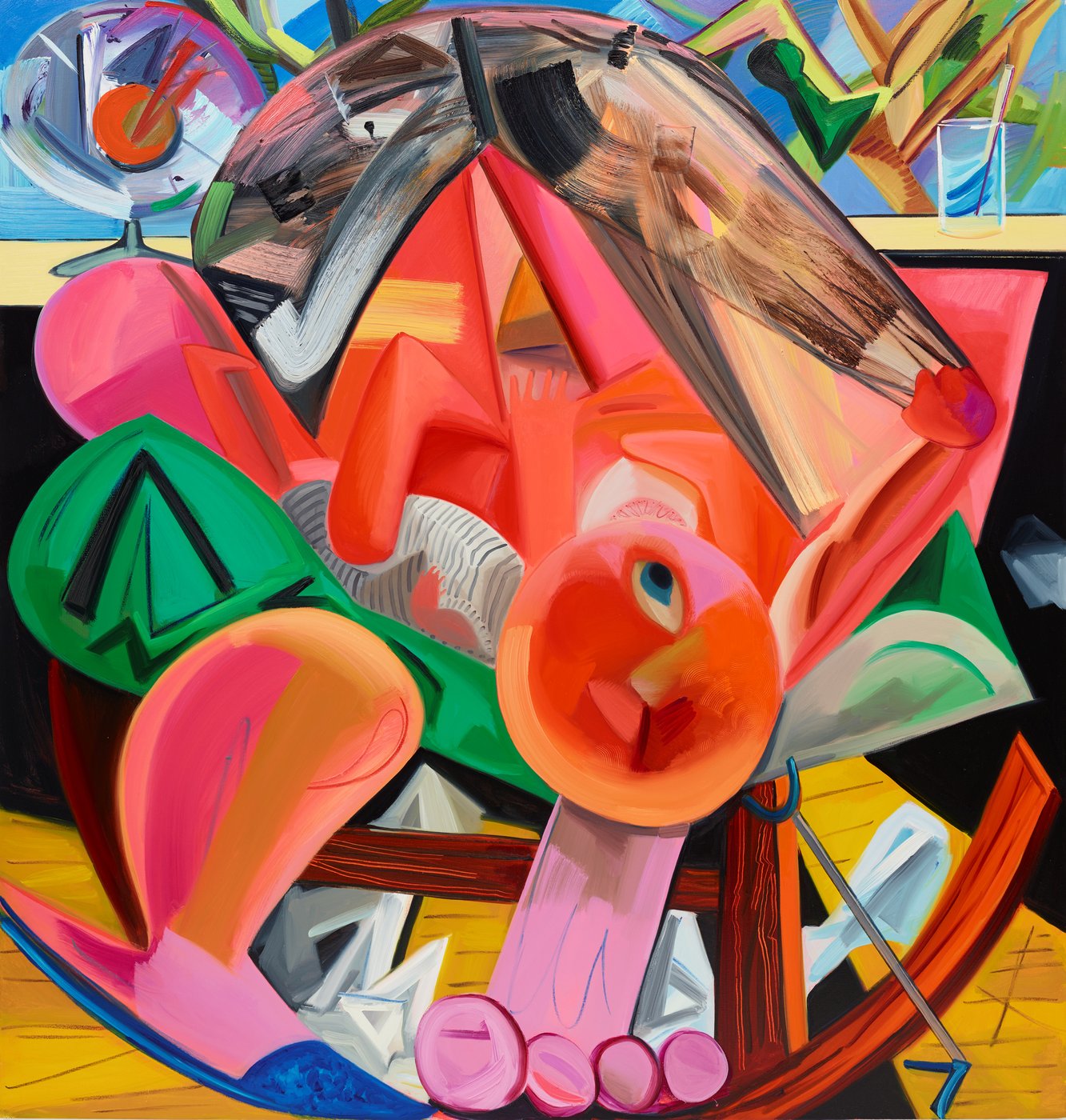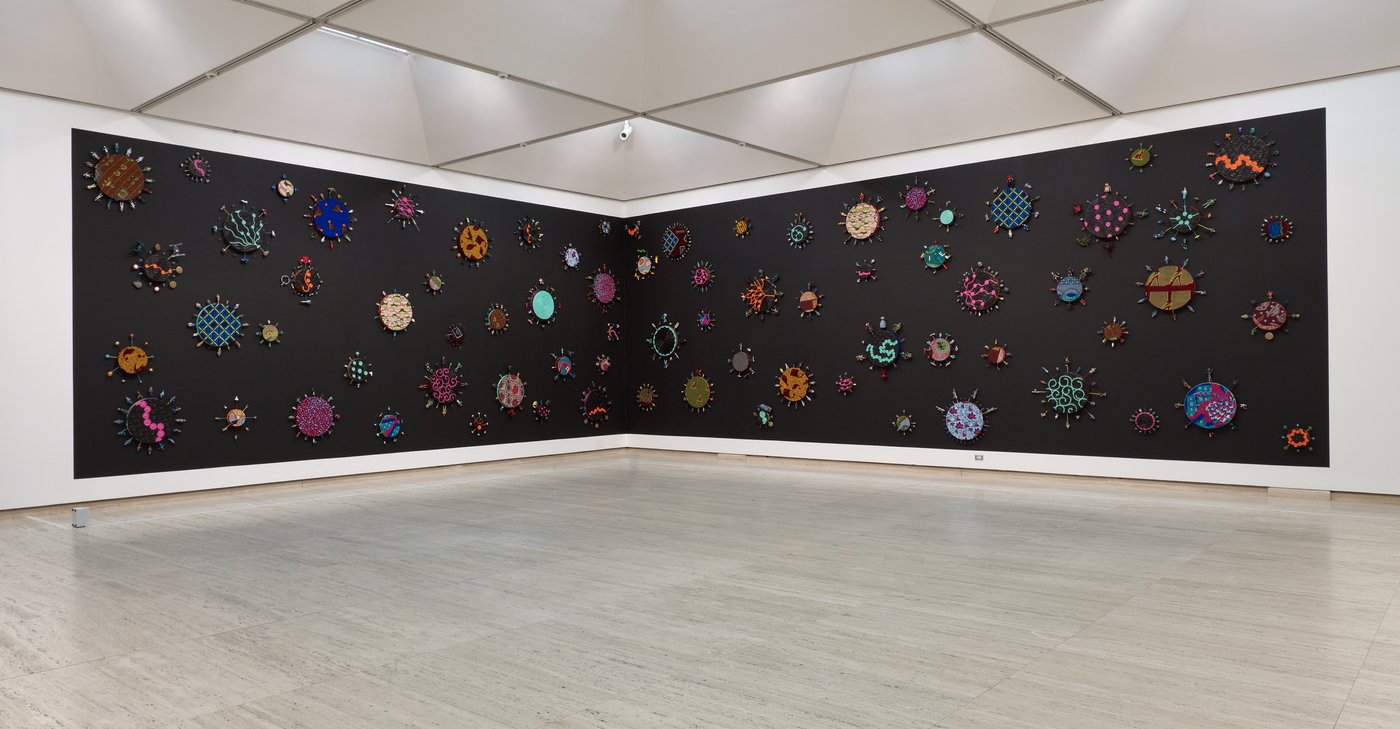Menu
Some mysterious process
50 years of collecting international art
Future directions
It is no longer feasible for a collection of international contemporary art to be fully comprehensive. However, the art displayed in the final spaces of the exhibition show how our collection has continued to expand its reach in the past decade, guided by new policies and priorities. There are works from Africa, South Asia and Southeast Asia, as well as Europe and the United States. Almost half the artists are women. We have also sought to balance scale, from the imposing painting by Georg Baselitz to the more modestly sized ceramic assemblages of Lubna Chowdhary. This exhibition does not have the space to highlight photography and video art but these two areas have also become strengths of our international collection.
These past 50 years collecting international contemporary art augur well for the installations we are planning for both of our buildings once the Sydney Modern Project is completed. A new focus will be site-specific commissions for the new building designed by Pritzker Prize-winning architects SANAA, and for outdoor spaces within our expanded art museum. One thing is certain: we will only be able to further expand our collection through the continuing generosity of our philanthropic benefactors. Thanks to them, we can be ambitious for the future of contemporary art at the Gallery.
Enlarge
Kamrooz Aram, 'Nocturne 3 (departing nocturne)', 2019
As an Iranian artist based in the United States, Kamrooz Aram often reflects on the relationship between Western modernism and non-Western art traditions. Nocturne 3 (departing nocturne) formed part of an exhibition in Dubai in 2019 titled Arabesque in which he explored the West’s historical fascination with the forms found in Islamic ornamentation. Aram’s forms not only reference American minimalism and the curves of Farsi script, but also evoke the work of Henri Matisse, who regularly incorporated stylised Islamic motifs in his paintings. In discussing the work, Aram draws attention to the ‘arabesque’ as a European construction which has its origins in an exoticised view of the Islamic world.
Nocturne 3 was purchased in Dubai by the Gallery in 2019 as part of our goal to broaden the reach of our international contemporary art collection to include works from the Middle East.

Michael Armitage, 'Man in the waves', 2019
Michael Armitage draws on popular culture, Western art history and the cultural traditions of East Africa. Fusing folklore, history and memory, both collective and personal, Armitage paints with oil on Lubugo bark cloth – a material traditionally worn by Uganda’s Buganda people during ceremonies or used as burial shrouds. The highly textured, organic material firmly locates his subjects and narrative in East Africa.
For Man in the waves, Armitage contemplated the idea of ‘the promised land’ and Gustave Courbet’s 1868 painting The woman in the waves. He also referred to the painting Three bathers 1913 by German expressionist Ernst Ludwig Kirchner, which Armitage encountered at the Gallery in 2018. Quoting Kirchner’s composition, Armitage replaces the female nude with a virile male figure, challenging Western art-historical stereotypes. The painting was acquired by the Gallery after it appeared in the 2019 exhibition Michael Armitage: the promised land at the Museum of Contemporary Art Australia.

Candice Breitz, 'Profile', 2017
Candice Breitz uses video to examine themes of identity and belonging, often through the lens of celebrity and popular culture. Made in collaboration with ten prominent South African artists, Profile is Breitz’s response to being one of two artists chosen to represent South Africa at the 57th Venice Biennale in 2017.
Igshaan Adams, Roger Ballen, Steven Cohen, Gabrielle Goliath, Dean Hutton, Banele Khoza, Gerald Machona, Buhlebezwe Siwani, Chuma Sopotela and Sue Williamson each introduce themselves to the viewer as Candice Breitz and make a series of statements relating to gender, race, occupation, class and nationality with varying degrees of credibility. Blurring fact and fiction, Breitz raises questions about representation and identity, asking how it is possible for any one individual to speak on behalf of many.

Lubna Chowdhary, 'Certain times IV', 2019
Lubna Chowdhary was born in Tanzania and raised in England, and has Indian and Pakistani heritage. Working primarily with ceramics, Chowdhary draws inspiration from childhood memories and her experiences of living in and visiting different places on multiple continents. Certain times is a series of sculptural assemblages comprising individual glazed ceramic tiles that, when combined in tableaux, take the form of abstracted city skylines. They fuse Western and non-Western visual traditions, as they forge connections between the opposing languages of minimalism and ornamentation.
This work was first seen at Art Basel Hong Kong in 2019 by the Gallery’s director, Michael Brand, and head of international art, Justin Paton. It was reserved for acquisition immediately as Chowdhary become one of the surprise hits of the art fair.

Nona Garcia, 'Recovery', 2017
Growing up in Manila where her parents ran a small hospital, Nona Garcia developed a familiarity with the tools and technologies of contemporary medicine. In 2013 she relocated to Baguio City on the edge of the Cordillera Central Mountains where many Indigenous communities live. Recovery investigates the landscape and customs of the people of this region by using x-ray images of objects linked to traditional religious and spiritual practices on 60 light boxes. These are arranged in the shape of a mountain to resemble the appearance of Baguio City at night.
Recovery was acquired in 2017 for the exhibition Passion and procession: art of the Philippines, expanding on the Gallery’s growing interest in Southeast Asian art.

Dana Schutz, 'Breastfeeding', 2015
At the beginning of her career, Dana Schutz’s intention was to paint things that were impossible. Using her seemingly limitless imagination as a starting point, Schutz asks questions – not about how an object or event looks, but examining instead how it feels. Over time her figurative paintings have become increasingly concerned with historical events, politics, popular culture and personal experience. In Breastfeeding, painted after the birth of her first child, Schutz illustrates a version of the maternal experience. Here, figures of mother and child appear to merge in a chaotic tangle of limbs; a wrestle between two forms that are barely recognisable as separate entities.
One of the first paintings Schutz completed after her highly successful Fight in an elevator exhibition in New York, Breastfeeding was purchased in 2015 following an Art Gallery of New South Wales Foundation tour to the United States where the group met the artist.

Yinka Shonibare, 'Alien toy painting', 2011
Yinka Shonibare is a multidisciplinary British artist of Nigerian heritage whose work is informed by issues relating to class, race, colonialism and globalisation. Describing himself as a ‘post-colonial’ hybrid, Shonibare examines cultural stereotypes and the creation of identity. Featuring printed cotton fabric, of a type manufactured for the African market in Dutch colonial mills in Indonesia, and space-themed plastic toys, the assemblage of shapes in Alien toy painting is reminiscent of a fleet of invading alien spaceships, or even microscopic disease molecules. Shonibare plays on the idea of alien invasion as a means to explore the history of migration around the world, using intergalactic objects to represent that which is foreign. In doing so, he draws attention to narratives of xenophobic nationalism on a global scale.
Apart from representing an artist who had recently been acclaimed for his ‘Fourth Plinth’ commission for London’s Trafalgar Square in 2010, Alien toy painting was acquired by the Gallery to broaden the diversity of our international contemporary art collection which has historically been poor in art from Africa and the African diaspora.

Dayanita Singh, 'Suitcase museum', 2017–18
Regarded as one of India’s most significant photographic artists, Dayanita Singh works primarily with black-and-white images, documenting scenes of everyday life in her homeland. She experiments with different methods of display to challenge the idea of photographs as static objects to be framed and hung on a wall. Singh’s wooden screens, book objects and installations place emphasis on the narrative qualities of photography and examine the way people think about and relate to images.
Singh’s Suitcase museum draws on a personal photographic archive spanning more than 30 years. It forms part of the ongoing Museum of chance project she began in the late 1980s. Comprising 44 framed book covers housed in two suitcases, the work is a mobile archive that can be arranged in multiple ways. The acquisition represents a continuing commitment to building our collection of contemporary art of South Asia, which now also includes works by Shahzia Sikander, Adeela Suleman and Zarina (who all feature in this exhibition) as well as Jitish Kallat, Nalini Malani and Sudarshan Shetty, among others.

